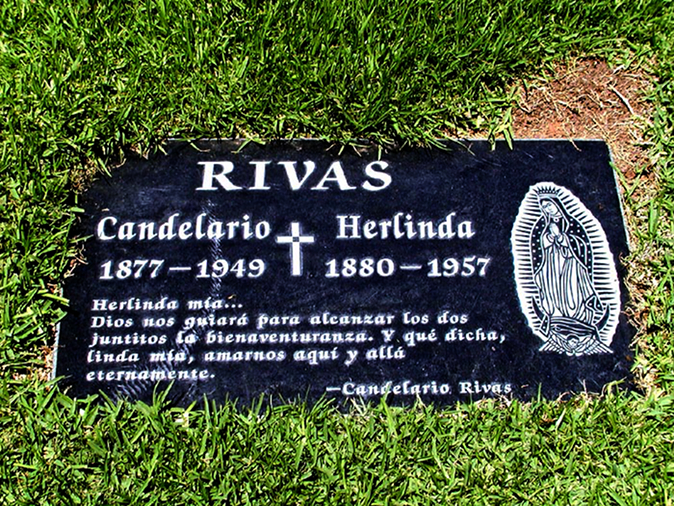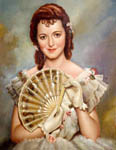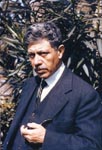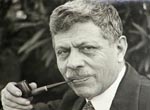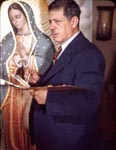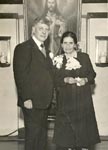Family Stories
It was one Saturday morning in 1935 that Candelario asked his friend Arturo Gutierrez to drive him to a studio in the Fairfax neighborhood of Los Angeles. He had with him a recently completed stunning portrait of Janet Gaynor, who was perhaps the most popular actress of the day. A new theater was being constructed downtown, and a commission would soon be awarded to decorate one of the interior walls with a large mural. Candelario intended to present his painting to the contractors and convince them that he was the most deserving of the new award. However, as they entered the large building, Candelario learned that the commission had just been awarded the day before. Because he did not know how to drive, he had waited for a ride with one of his friends, and missed his opportunity due to this delay. This was a significant loss for Candelario, and he was understandably very disappointed.
When asked by his friend Arturo what would become of the painting, he replied that he would probably just paint over it. Of course this alarmed Arturo and his wife, Maria Elena, and they begged him to sell it to them. Candelario refused to sell it, thinking that the painting of Janet Gaynor represented a failed endeavor. But after much friendly persuasion, he agreed to give them the painting in exchange for driving lessons.
For the the next month, Arturo and Maria Elena did their best to instruct Candelario in the needed skills to safely drive a vehicle, but it was a losing battle. At fifty-seven years of age, it was a bit late for the great artist to master driving a car, and after banging into the local mail truck, he found it best to get around by streetcar and rides from his many friends. And family members recall gracious outings with visitors when they all used the well-networked street cars of the city of Los Angeles.
For a number of years, Manuela, Candelario's and Herlinda's oldest daughter, had expressed her desire to to become a nun and dedicate her life to prayer and care of the sick. The family believes that it was in 1934 that she joined the Dominican order in Los Angeles. However, Manuela's expectations and the reality of convent life were far apart, and she suffered a devastating nervous breakdown that brought her back to the household in just six months. Manuela lay in bed for a year, unable to recognize her own family, except for brief moments when she seemed to recognize her brother Salvador. Even her own father's presence frightened her. Seeking available medical help, Candelario soon exhausted his financial resources, and then Salvador gave nearly every penny he had as well, all to no avail.
It was during this moment of desperation that an acquaintance of Candelario's, a Franciscan priest, came to their home one evening to lead the family in prayer. After prayers, he asked that Manuela be brought to him. With the entire Rivas family watching, the priest placed his rosary over Manuela's head and instantly brought back her memory. She went on to recover her health and about a year later, she joined the Franciscan Sisters and spent the rest of her life in missionary work, as she had always wanted to do.
After years in the states, Candelario and Herlinda were enjoying life in Los Angeles, and their young daughters remember a carefree life. But from time to time, Candelario would let his mind drift back to the stressful last days in Mexico when he desperately and cunningly hid his magnificent murals of the Santuario de Guadalupe church in Zacatecas. Except for brief business trips to Tijuana*, Candelario was too afraid to ever return to his homeland.
Because of Candelario's fame as an artist, Herlinda and he would often host distinguished visitors of the Church and some from Mexico. One night they hosted the wife of a well-known politician from Mexico. In the midst of discussing his various commissions from Zacatecas, she asked him if he knew whatever became of his murals that were filled with angels, who made a path in the sky to heaven. Candelario replied that he had no knowledge of their whereabouts. Soon afterward, he confided to his friend Arturo that he hated to lie, but that no one could be trusted with knowledge of the location of the murals without ironclad referrals from unimpeachable sources.
The lady visitor continued on her way north to see other important individuals in the San Francisco area, and while she did so, Candelario contacted a very trustworthy friend of his who was soon to be consecrated a bishop of San Francisco. When asked about the character of his recent visitor, the monsignor replied that he would vouch for the honor and loyalty of their mutual friend. And so Candelario came up with a plan that would bring the famed murals to his household.
Candelario invited the politician's wife to visit his home again on her way back through Los Angeles. When she arrived, her host astonished her by revealing all that he did to hide the murals, and where they lay buried underground for over a decade. In a matter of months she returned to the Rivas household and presented to Candelario the lost murals of Zacatecas. Soon they were hung on display from the top of the interior walls of the Rivas home.
On one occasion, his friends tried to persuade him to exhibit the awe-inspiring murals at the Biltmore Hotel, at the time the finest hotel in Los Angeles. But Candelario declined; such was the renown of the murals, that he feared that a representative of the Mexican government, such as a consul, might recognize them as the lost Zacatecan murals, and demand their return as property of the Mexican government.
One night, to meet a deadline, Candelario worked very late into the early morning hours in his home studio. Fatigued, he absentmindedly placed his still warm pipe in the pocket of his smock next to rags damp with turpentine he had just used to clean his brushes. A couple of hours later, at about four in the morning, the family was awakened by an intense fire which had already engulfed the studio. They all fled safely from the house that night and only the studio was lost; yet sadly, the murals that had remained sealed for so many years were totally destroyed. Several other masterpieces were also lost, including other old works from Mexico.
Years later, Candelario was asked what he missed the most from all the art that was destroyed by the fire. He didn't hesitate for one second in his reply. It was Herlinda's diploma, the document that contained the very picture that had caused him to fall in love forever with his beloved wife.
Candelario Rivas repeatedly refused to work for the Hollywood movie studios. But on one occasion, with work hard to come by, he accepted a week long commission to paint a castle with pastels on a three by four foot blackboard. It was a last- minute requirement by MGM, and he received a handsome fee worth about three months rent ($100). The studio was pleased with the pastel work and it was used in the movie The Wizard of Oz as the wicked witch's castle. Soon after, he was offered a full-time job. Not easily persuaded by money, Candelario declined the offer and told his family that he would have lost his soul in the corruption of the film industry.
Candelario never bought a house in Los Angeles, but would rent for long terms. The family remembers a difficult time when work with the Heinsbergen Studios ended, and they had to inform their landlord, a Mr. Aylor (a respected railroad official), that rent money was unavailable. Mr. Aylor appreciated having the master painter and his family as tenants, and forgave the debt while times were tough. Candelario was so grateful for his landlord's generosity, that he painted what his family would later recall was a most remarkable portrait of his landlord, unbelievable in its fine detail. Mr. Aylor was very appreciative, and had the painting carefully crated and shipped to his mother back East.
From Pancho Villa to the Wizard of Oz
Candelario Rivas stood five feet six inches tall, with green eyes and the perfect hands of an artist. He was truly one of the great expositors of the classical and neoclassical approach to art. A family man first, and with the adventurous spirit of a child who ran away with the circus, his life's work continues to inspire many observers from the historical city of Salamanca to and beyond the sophisticated metropolis of San Francisco. Don Candelario painted all his life. He passed away suddenly from a heart attack on June 29, 1949 as he was taking a break from painting to enjoy some recent photographs of the family. As the University of San Francisco noted, "His death deeply grieved his bereaved wife and children, and he was deeply mourned by priests and religious for whom he had worked." Herlinda lived another seven years, residing in contentment with Carmen's and Maria Elena's families in Lynwood, California.
